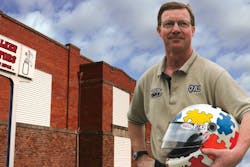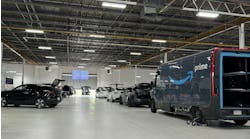Talk about a fast start.
Brent Walker, owner of Walker Motors Collision Repair in rural Memphis, Mo., saw a natural synergy between his shop and neighboring motor sports parts business Art’s Racemart. What’s the connection? Walker, besides repairing cars every day, spends his weekends supporting a racing team at dirt tracks all over Missouri and surrounding states—so he knows racing parts and the customers who need them. With that in mind, he acquired the parts retailer in January and opened for business in March, figuring it wouldn’t be too much of a stretch to sell the parts himself. He also guessed that race teams coming in for parts might use his collision shop for their street cars.
Walker was right on both counts. But the boost to his revenues since he opened Art’s Racemart has exceeded even his expectations. Before the acquisition, Walker Motors Collision was doing upwards of about $1 million in sales annually. Now, Walker says, “At the pace we’re going, the racing business could double my gross sales for the year pretty easily.”
FROM HOBBY TO HIGH SCHOOL
Walker has repaired cars for as long as he can remember. His father, Floyd, was a banker who liked to fix and sell cars for a little extra cash for his family. The hobby rubbed off, and the younger Walker spent part of his senior year in high school working in a local body shop for class credit. Not long after he graduated in 1975, that shop closed, and Walker had to make a decision.
In 1982, Walker bought the town’s vacant high school, securing a happy fate for the historic building as well as a commitment to Memphis’s 2,000 residents. “I was in the last class to graduate from this facility,” Walker says. “Now they can’t throw me out of school, because I own it.”
Walker Motors Collision Repair and Art’s Racemart occupy two brick buildings, totaling about 8,500 square feet. The building closest to the street houses the main portion of the shop’s business, including mechanical repair, service work, struts, shocks, brakes, suspensions, tune-ups, wheel alignments, custom exhaust, oil changes, glass repair and replacement, and a small towing business. Walker estimates his business repairs between 4 and 10 cars a week. The second building, set behind the first, houses most of the autobody work, with a frame machine, downdraft paint booth and bake-off oven with infrared curing. “We mix our own paint and use the Sikkens paint line exclusively,” Walker says. That’s been the case since 1986.
INTEGRATING RETAIL SALES
Art’s Racemart shares space in the second building, occupying a new showroom. Inventory for the parts business includes everything from brake lines and shocks to helmets and suits. “The only things we don’t sell are the engines and decals—although we might start doing decals, since every car is plastered with them,” Walker says. “It’s just like a Wal-Mart, where you go in for Q-tips and come out with $800 worth of stuff,” he says about his one-stop shop. “Racers will come in for one part, and then remember what else they need.”
Art’s Racemart also does an impressive business shipping its parts around the world, through its own Web site and eBay. “We’re a small player compared to bigger names that have 100,000 square feet and UPS pulling semi-trailers up to the back doors,” Walker says. “But we’ve shipped to Hong Kong, Venezuela and every state in the U.S. I’d say there’s no limit to growth on that side.”
Before Art’s Racemart was acquired by Walker, the parts business also built race car chassis, selling about a dozen a year. That’s a service Walker might add someday, after he feels that they’ve got the parts retail business down pat. “We’ll have to choose whether to expand part sales or add more people and manufacture chassis,” Walker says.
For chassis manufacturing, he notes, “You have to make sure you’re producing a top-notch product, and you’d better have some in the field that are winning races. What wins on Sunday sells on Monday.” The most important part of building a chassis, Walker says, is bending and welding the metal tubes that become the frame. “You need the craftsmen to be able to repeat that time after time. We’re not going to do it unless we can do it well.”
FOLLOWING THE NATURAL FIT
For Walker, doing what he loves and knows well is a recurring theme, one that has helped his business grow nearly every year (all but two, actually) since 1980. For example, Walker specializes in shock absorbers and is an authorized shock rebuilder, so he’s constantly testing new products and materials in his team’s race cars before he sells them to customers. “I have the same testing equipment that NASCAR uses.”
By the same token, Walker doesn’t try to be everything to his customers. His shop has never rebuilt engines or transmissions, for example, because he’s just never been interested in that work. “And if I don’t understand what I’m doing from the ground floor to the finished product, I’m not as comfortable as I need to be in a business venture,” Walker says.
A fan of auto racing for more than 30 years, Walker also finds a good fit in sponsoring Tony Fraise, a modified stock car driver from nearby Donnellson, Iowa (50 miles from Memphis). By spending his weekends at the tracks, Walker not only gets to do what he loves, he’s also networking and promoting his collision repair and race car parts businesses at the same time. “You meet a lot of people in collision repair through motor sports,” Walker says. “Apparently, we all spend our time off around cars and working on them.”
EMBRACING THE COMMUNITY
Walker counts himself lucky to have grown up in a place he loves, surrounded by people who love collision repair and auto racing as much as he does. He has long-time employees on the collision side “who could get a job in the metro area just by picking up the phone,” he says. So far, the collision and race parts businesses are separate enough that his employees haven’t had to take on more work—except for Ellen Clark, his administrative assistant, who quickly mastered the extra paperwork. “We would be lost without her,” Walker says.
He also relies heavily on Kevin Kearns, his general manager for the collision side, as well as on Art Jeffries, the general manager on the racing side (he’s the “Art” in Art’s Racemart and Walker’s childhood friend). “Art Jeffries has 30 years of experience driving dirt race cars and 10 years’ experience selling parts. He came with the acquisition and knows the customer base by name. Without good people,” Walker says, “you’re in trouble.”



